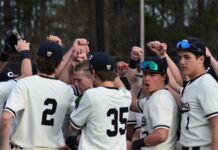It’s a date most of us in Alabama know by heart now. Three years ago, a generational super storm ripped through the heart of the South, spawning 211 tornados over the course of 24 hours. Sixty-three of them were in Alabama. Of those four were EF5s, meaning they caused absolute destruction to everything in their path. This marked the second time in history more than two EF5s occurred in a single day. The other was April 3, 1974. Almost 300 people lost their lives that day, 238 of them in Alabama alone. Economically, the storm caused over $11 billion in damage.
I will go ahead and apologize to the readers before I go any further with this article. It won’t be your typical my view or cold third person piece. Instead, it will blend and bring many of you into it as well. It’s nigh impossible to remove yourself from something so personal. I doubt there is anyone in Central or North Alabama who wasn’t part of the history of that day. Either we all lost someone, knew someone who did, or participated in the recovery efforts soon after. I was fortunate enough not to lose anyone, and no one close to me lost anything to the storms. My roommate at the time and I did help raise money for those affected, donated food and clothing, and volunteered time to help cleanup.
Earlier this weekend, a gentle thunderstorm rolled past where I live. Soft rains, virtually no wind, but an impressive display of lightning for a few hours. I had been watching the news and regularly checking the Weather Channel online. I knew, west of us, another large storm had begun and was set to impact us over the next 72 hours. That seemed hard to fathom as I stood on my porch and looked on as a few rays of sunshine fought its way through lingering clouds and then tried to punch its way past the pine and oak treetops still dripping from the previous showers. It was beautiful, a little humid, but the temperature felt just right. It almost smelled too clean. Before I knew it, it was the now cliché and actual calm before the storm though. Looking outside this week, I knew it would be a very different scene.
We all briefly panic now when the tornado sirens wail. It’s hard to tell ourselves this is Alabama in April and this is normal. What happened in 2011 wasn’t normal. That was an event that only happens every 40 years or so. Odds are I will be a grandparent before such another event occurs. We won’t see 63 tornadoes tomorrow. We probably won’t see an EF5. We won’t see Tuscaloosa, Cordova, Hackleburg, Phil Campbell, Rainsville, Pratt City, Harvest, Hueytown, Cullman, Pleasant Grove, McDonald Chapel, Tanner and Concord all sustain massive damage in a period of less than 12 hours. We won’t.
I can still remember waking up just after 5 a.m. that morning to the sirens going off. I remember turning on the news and seeing the first squall line begin moving into the Birmingham metro area, how unsettling it was to see the power grid in downtown go offline, and the city blackout on the TV block by block. At 9:30 a.m., I showed up for work at my scheduled time and within a couple of hours, they announced schools closing and then we shut down. By then the first tornadoes had started. When I typed the cities above, I heard in my head the way the man on the weather radio said their names and called out the dangers associated to each. I remember vividly the image of the Tuscaloosa tornado passing north of Birmingham on the news, the camera not even able to capture the whole thing at once because it was too large. At that moment, all I thought was thank God it missed Birmingham because I didn’t know if the state would be able to recover if it hadn’t.
So, all this crosses my mind with what has come over the last few days, as I’m sure similar memories do for everyone else. We will see severe weather. We will likely see tornadoes. We will have people who need help putting their lives back together just like three years ago. There just won’t be as many affected this time. What can you do to help?
First, help yourself by being prepared and staying informed. This can help everyone more than you would imagine. Every household should have the following if you are ever in a storm’s path: a weather radio (wind-up or battery operated), flashlights or battery operated lanterns, spare batteries for everything, a first aid kit, a couple of light blankets and towels. Keep these things in a backpack or duffel bag, something easy to grab and close to your safe spot. Your safe spot should be the lowest level, most interior room available. Make sure everyone in the house knows the safe spot. Do not assume you’ll have power, assume the opposite. For every person in the household, also pack a duffel bag with two days worth of clothing (including a light jacket and a pair of jeans), several bottles of water, some cans of soup, pop tarts or granola bars and a bicycle helmet (wear the helmet when you are forced into seeking shelter).
Adults should make copies of IDs and any household prescriptions and keep those in there, as well as an extra charger for their cell phone. This means being prepared before the storm hits. Keep your wallet or purse and keys close by as severe weather moves closer. You may not have time to find these items when the storm comes. Also, keep your phone as charged as possible. Do not worry about nonessentials. You will have limited time and only two hands. Be smart about it. Take warnings seriously. After the storm passes, get away from debris and rubble. Alert emergency personnel and follow their instructions. As soon as it is safe, let loved ones know you’re alright. Then be a good neighbor. Together is the only way we will all get through these storms as we have a dozen others.






















